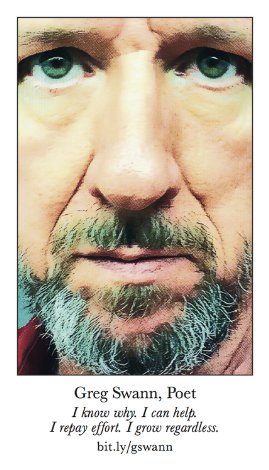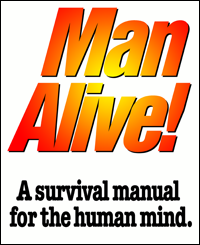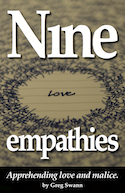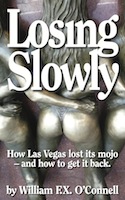
- Everyone knows how to motivate a villain. You have him rub his hands together with an evil relish and snarl, “Nyar har har har!”Kaptain Kobold / Foter / Creative Commons Attribution-NonCommercial-ShareAlike 2.0 Generic (CC BY-NC-SA 2.0)
I wrote this on April 11, 2012, three days after I had published Man Alive. I had no idea at the time how much more fecund that book was going to make my own intellectual life. I thought I was documenting what I had discovered. Instead, I ended up discovering so much more to document. The posts I have written about art are one example of that, but the underlying changes in my own ideas about art are more significant to me. Nota bene: The improvement in own’s own thinking over time is benedy-in-real-life. But Brother Willie and I have had a hard way to go, since I no longer want to write satire. That joke is on me, even so. Willie is an impossible satiric contradiction, an intentional Butters: He is morally-neutral not by accident of idiocy but by explicit intent. You see Willie discovering #MyKindOfBenedy over the years when he says, “But everybody’s gotta take a side.” I have notions about redeeming satiric forms with benedic endings, but those ideas are still percolating. Meanwhile, behold the Splendor of Willie. –GSS
I worked on the ideas that became Man Alive for more than thirty years, since I was nineteen years old. And the problem I started with was more practical than philosophical: I was a young wannabe novelist, and I could not for the life of me figure out how to motivate a villain.
That might sound silly to you. Everyone knows how to motivate a villain. You have him rub his hands together with an evil relish and snarl, “Nyar har har har!” You’ve seen it in the movies a million times. Does he need some back-story? His parents were rich but neglecting and the butler buggered him in the basement. What could be simpler?
Reality, as it turns out. I was living in New York City at that time, going to school full-time and running the student newspaper, all while working full-time as well. All around me there were people I didn’t like and people who didn’t like me, and some of them were doing things I knew were morally wrong, but none of them were Hollywood-style villains. They were just people, in most cases largely decent people with a few bad habits.
But, but, but… New York is full of criminals – muggers below and rapacious tycoons above. I worked in Wall Street in those days, and I got to meet a few of each. And guess what? They were just people, partly noble, partly ignoble, mostly just ordinary. Anything you might describe as being evil in their behavior emerged from the exigencies imposed by the accretions of bad habits, not from some sort of hypothesized will-to-evil.
I’m not excusing evil. What I was trying to do in those days was to understand it. And I met and studied a lot of people, but I never met anyone who set about to screw up his life, and to this day I have never met anyone whose motivation for injuring himself or other people was any worse, on the Hollywood scale of evil, than spite.
This is all easy for me to understand now, to the point that I have zero interest in the idea of the villain in fiction. True villainy in real life, to the extent that it exists at all, is just ordinary everyday evil scaled up to monstrous proportions. And a lot of what people insist must be villainy is very likely heroism in the eyes of the putative villain.
Want proof? Had the British been more committed to their cause, George Washington would be remembered, if at all, as a minor-league colonial insurgent who was hung for treason.
Once I understood that there really are no villains, just ordinary people who have managed to screw up their own lives, and the lives of the people around them, with their bad habits, I lost all interest in writing about villainy as a source of conflict in fiction. In the novels that I wrote, I concerned myself with heroic characters who became still better people in the arc of the story. And in the Ramblin’ Gamblin’ Willie stories, I portrayed evil as I saw it then and see it now: Small and comical and pathetic and unnecessary.
And even then, I was much more interested in the good. Willie’s own back-story obliged him to be indifferent about the people he wrote about, but he could never quite make it stick. When he says, “Everybody’s gotta take a side,” he means he has to take the side of the good, even if despite himself.
And it was fun for me, when I was revising Man Alive, to see how many Willie stories were in there, between the lines. I hadn’t thought about those stories at all when I was drafting the text, but I could see them clearly when I had a chance to take some perspective on what I had written.
I have more than seventy-five of those stories on my web servers, and there are others out there that I didn’t retain and have never archived. Some of them are great, in my opinion, some awful, and most are simply satires – humorous tragedies. But all of them are about ideas – the ideas I have been thinking about for my entire adult life.
Here are some of the ways Willie shows up in Man Alive – or – here are some ways of understanding the ideas discussed in Man Alive in fictional form:
Children are everywhere, of course. I see a world full of children. Marla the Adorable was first, with a story about how parents unwittingly terrorize children into mistrusting their own minds. Cinderella’s memories of the zoo takes up the irrepressible persistence of memory and how that is shaped by your attitudes. And my all-time favorite Willie story, Anastasia in the light and shadow, illustrates the birth of Fathertongue in the mind of a four-year-old girlchild.
Anastasia is a good example of how your own values influence what you see as being heroism or villainy. To you, Willie is a sedentary hero in that story: He is helping a sweet young girl grow into her mind, subtly influencing her toward a life of intellectual independence. But to an Islamist imam, Willie is shamelessly and subversively indoctrinating – beguiling, even – a helpless child in a creed of defiance, rebellion, intransigence.
The so-called paradoxes of theoretical physics are taken up in How Cosmo overcame trans-universal envy and Why the quantum leapers didn’t leap, and the vice that is obsessive error-correction is addressed in ‘Wha’s happenin’?’ ‘Nothing. Go back to sleep.’ Satirical and farcical writing has always turned on the comic consequences of errors of knowledge, but I think I may be the only contemporary author who directly mocks epistemological errors in fiction.
Everyone gets what he deserves? Take a look at A dumpster diver’s Christmas. What does the hook-up culture really look like? See The Desperation Waltz – “desperate people milling about in the desperation waltz, silently sizing each other up and silently tearing each other down.” How do you express indomitability in real life? Willie’s answer is in How to slay dragons. All three of those are Backstory stories, as are many of the Willie stories: We always start in the middle, but it is the accumulated errors of inverted value structures that bring the characters to where they are as the action commences.
Willie pokes a gentle kind of fun at my style of egovangelism in Reflecting His Radiance, but, in the end, “Everybody’s gotta take a side.” Willie grows into that theme with another wonderful child in Xavier’s destiny.
There are a lot of demanding ideas in Man Alive, but the one that causes people the most trouble, I think, is the Calculus of Loss. When you behave righteously, doing no intentional harm, you should feel better about yourself, right? That’s what we insist to ourselves. And yet, any harm you do inadvertently, to your self or to other people, even when you are acting with scrupulous care, can diminish your own self-regard. And what about effecting topical justice, like tearing your purse away from a snatcher – shouldn’t that make you feel wonderful? How do we react to the news that it does not? We are what we are, not what we insist we “must” be, and when lives collide, often everyone involved gets hurt. The damage to your future self-adoration will be worse if you acted in knowing evil, but a scar is still a scar however you got it.
All of that is taken up in A canticle for Kathleen Sullivan, the most brutally, unforgivingly painful thing I have ever written. The story turns on habituated virtues and vices, but the villain – who killed a mother and crippled her daughter – is just an ordinary everyday thoughtless dumbass. I challenge you to get to the end without crying for him – and for what you can see of yourself in him.
I’ll end on a lighter note – or at least as light as Brother Willie ever manages to get. How the bank robbed Bonnie and Clyde is mainly just funny. There are all kinds of Backstory games going on, but the main focus is how pathetic, ineffectual and banal evil actually is.
Are you looking for a villain in life? I can’t find any, and I’ve been looking for decades. All I see are ordinary people. Most of us manage to muddle through. A few make war on their own identity and on the identity of the universe, resulting in perverse, self-destructive behavior – with some of them deploying other people as the means to their own self-destruction.
But none of us is beyond redemption – “the conscious choice to do better in the midst of chaotic life” – because each one of us wants to be good. We’ve just never learned how.















